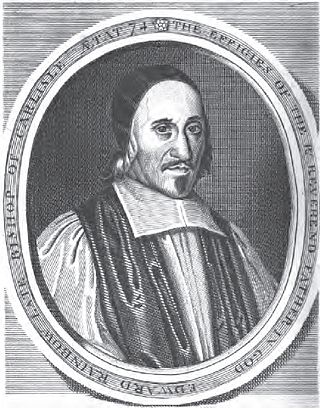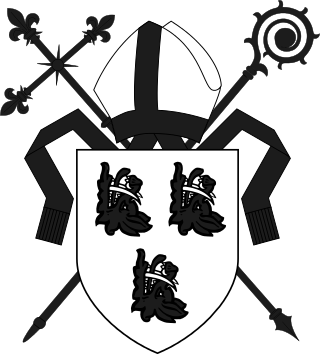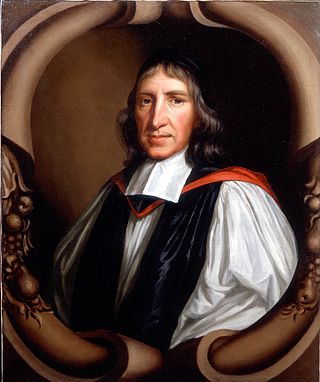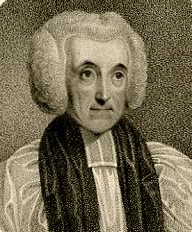Related Research Articles

Saint Patrick's Cathedral in Dublin, Ireland, founded in 1191 as a Roman Catholic cathedral, is currently the national cathedral of the Church of Ireland. Christ Church Cathedral, also a Church of Ireland cathedral in Dublin, is designated as the local cathedral of the Diocese of Dublin and Glendalough.

Edward Rainbowe or Rainbow (1608–1684) was an English academic, Church of England clergyman and a noted preacher. He was Master of Magdalene College, Cambridge, Vice-Chancellor of the University of Cambridge and Bishop of Carlisle.
In Christianity, a collegiate church is a church where the daily office of worship is maintained by a college of canons, a non-monastic or "secular" community of clergy, organised as a self-governing corporate body, headed by a dignitary bearing a title which may vary, such as dean or provost.

A chapter is one of several bodies of clergy in Roman Catholic, Old Catholic, Anglican, and Nordic Lutheran churches or their gatherings.

The Dean of St Patrick's Cathedral is the senior cleric of the Protestant St Patrick's Cathedral, Dublin, elected by the chapter of the cathedral. The office was created in 1219 or 1220, by one of several charters granted to the cathedral by Archbishop Henry de Loundres between 1218 and 1220.

Lawrence Booth served as bishop of Durham and lord chancellor of England, before being appointed archbishop of York.

John Lake was a 17th-century Bishop of Sodor and Man, Bishop of Bristol and Bishop of Chichester in the British Isles.
According to both Catholic and Anglican canon law, a cathedral chapter is a college of clerics (chapter) formed to advise a bishop and, in the case of a vacancy of the episcopal see in some countries, to govern the diocese during the vacancy. In the Catholic Church their creation is the purview of the Pope. They can be numbered, in which case they are provided with a fixed prebend, or unnumbered, in which case the bishop indicates the number of canons according to the rents. These chapters are made up of canons and other officers, while in the Church of England chapters now include a number of lay appointees.

John Droxford, was a Bishop of Bath and Wells. He was elected 5 February 1309 and consecrated 9 November 1309.
William Grey was a medieval English churchman, academic, and Lord High Treasurer. He served as Chancellor of Oxford University and as Bishop of Ely.
Lewis de Charleton was a medieval Bishop of Hereford in England.
Arthur William Thomson Perowne was an Anglican bishop in Britain. He was the first Bishop of Bradford and, from 1931, was the Bishop of Worcester.
William Lloyd was a Welsh-born Anglican bishop. He was deprived of his see in 1691 for being a non-juror.

Spencer Madan (1729–1813) was an English churchman, successively of Bishop of Bristol and Bishop of Peterborough.

Thomas Balguy (1716–1795) was an English churchman, archdeacon of Salisbury from 1759 and then Archdeacon of Winchester.
Christopher Plummer was a Canon of Windsor from 1513 - 1535. He was attainted and deprived in 1535.

Robert Woodlark was an English academic and priest. He was the Provost of King's College, Cambridge, and the founder of St Catharine's College, Cambridge. He was also a professor of sacred theology at the University.
Anthony Martin was an Anglo-Irish Anglican priest who served as Provost of Trinity College Dublin from 1645 to 1650. during the first half of the 17th-century.
Henry Smyth, D.D. was a 17th-century priest and academic.
Edward Abbott was a priest of the Church of England and academic.
References
- ↑ "The diary of Samuel Pepys: for the first time fully transcribed from the shorthand manuscript in the Pepysian library, Volume 13" Wheatley,H.B p132: New York, George E. Croscup, 1905
- ↑ "Fasti Ecclesiæ Anglicanæ: Or, An Essay Towards Deducing a Regular Succession of All the Principal Dignitaries in Each Cathedral, Collegiate Church Or Chapel (now in Being) in Those Parts in Great Britain Called England and Wales, from the First Erection Thereof to this Present Year 1715: Containing the Names, Dates, of Consecration, Admission, Preferment, Removal Or Death of the Archbishops, Bishops, Deans, Praecentors, Treasurers, Chancellors and Archdeacons, in Their Several Stations and Degrees. To which is Added The Succession of the Prebendaries in Each Prebendal Stall (of Most of Those Erected at the Reformation, And) Continued Down to this Time: as Also of the Heads Or Masters of Each College Or Hall in Either of Our Famous Universities, from Their First Settlement to this Time. The Whole Extracted from the Several Registers of the Respective Cathedral Or Collegiate Churches Or Foundations, as Also from Other Authentick Records and Valuable Collections Never Before Publish'd" by John Le Neve p405: J. Nutt: and sold by Henry Clements, at the Half-Moon, in St. Paul's Church-yard; Charles King at the Judge's Head in Westminster-Hall; and Edward Nutt, at the Middle-Temple Gate in Fleet-Street., 1716
- ↑ Alumni Cantabrigienses: A Biographical List of All Known Students, Graduates and Holders of Office at the University of Cambridge, from the Earliest Times to 1900, John Venn/John Archibald Venn Cambridge University Press > (10 volumes 1922 to 1953) Part I. 1209–1751 Vol. ii. Dabbs – Juxton, (1922) p420
- ↑ "A Survey of the Cathedrals of York, Durham, Carlisle, Chester, Man, Litchfield, Hereford, Worcester, Gloucester, Bristol, Lincoln, Ely, Oxford, Peterborough, Canterbury, Rochester, London, Winchester, Chichester, Norwich, Bangor, and St. Asaph: Containing an History of Their Foundations, Builders, Ancient Monuments, and Inscriptions; Endowments, Alienations, Sales of Lands, Patronages. Dates of Consecration, Admission, Preferment, Deaths, Burials, and Epitaphs of the Bishops, Deans, Precentors, Chancellors, Treasurers, Subdeans, Archdeacons, and Prebendaries, with an Exact Account of All the Churches and Chapels in Each Diocese; Distinguished Under Their Proper Archdeaconries and Deanries; to what Saints Dedicated, who Patrons of Them, and to what Religious Houses Appropriated. The whole illustrated with Thirty Two Curious Draughts of the Ichnographies, Uprights, and Other Prospects of These Cathedrals" Willis,B p519: T. Osborne in Gray's Inn and T. Bacon in Dublin, 1742
- ↑ "A Catalogue of the Manuscripts Preserved in the Library of the University of Cambridge" H.R. (Ed) p221 Cambridge, Cambridge University Press, 8 Dec 2011 ISBN 9781108034371
- ↑ "The History of the University of Cambridge, from Its Original, to the Year 1753: In which a Particular Account is Given of Each College and Hall, Their Respective Foundations, Founders, Benefactors, Bishops, Learned Writers, Masters, Livings, Curiosities, &c. Together with Accurate Lists of All the Chancellors, Vice-Chancellors, Proctors, Taxers, Professors, Orators and Members of Parliament" Cater, E. p413: London, Davis & Woodyer, 1753